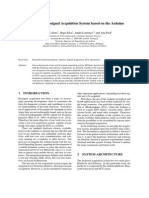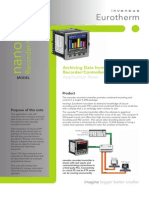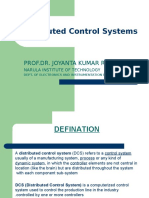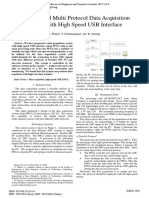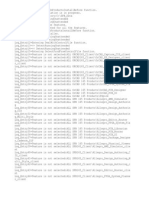A Measuring System
A Measuring System
Uploaded by
Monal BhoyarCopyright:
Available Formats
A Measuring System
A Measuring System
Uploaded by
Monal BhoyarOriginal Description:
Copyright
Available Formats
Share this document
Did you find this document useful?
Is this content inappropriate?
Copyright:
Available Formats
A Measuring System
A Measuring System
Uploaded by
Monal BhoyarCopyright:
Available Formats
current pulse and store it for an offline
analysis. Another system is installed in the
room of the high voltage pulser to measure
the thyratron voltages.
A measuring system for Kicker
and Septa pulses
J.Hildemann, DESY MIN, 22603 Hamburg
E-Mail: hildeman@min1.desy.de
Hardware
There are two different systems used to
measure the 12 signals. One system consist
of a Hewlett Packard 3488A multiplexer,
two HP 54542A oscilloscopes and a PC
with an National Instrument (NI) PC DIO
24 data acquisition card to get the status of
PETRA and a NI GPIB card to control the
multiplexer and the oscilloscopes. The
HP54542A oscilloscopes can measure with
a sampling rate up to 2Gsamples/s and the
data is read out with the NI GPIB card.
The other system consist of a PC with an
National Instruments AT MIO 16 E-1 data
acquisition card which can measure 4
channels with a sampling rate from 250
ksamples/s for each channel. Both PCs
have a Intel Pentium 133 MHz processor
and they are connected via a LWL-Ethernet
connection to a Novell 3.12 fileserver to
store all the data. For maintenance there is
one additional system, which measures the
voltages of the thyratrons in the high
voltage kicker pulsers and stores it on the
same fileserver as the other systems. Its
one PC with an National Instruments
LPM16 data acquisition card.
Abstract
Since 1994 we are working on a measuring
system for Kicker and Septa pulses. The
system measures the current pulses of the
PETRA ejection and HERA injection
devices for protons and electrons/positrons.
The current pulses are transmitted via
lightwavecable to the electronic room near
the control room. To measure up to 12
signals we use one Hewlett packard 3488
multiplexer and two digital 4-channel
Hewlett Packard oscilloscopes for the fast
kicker pulses (the shortest has a pulse
length of 1 us) and 1 PC with an National
Instruments DAQ card AT-MIO 16 E1 to
measure 4 slower septa pulses.We use 1 PC
to read the 2 oscillocopes and to control
the multiplexer with the GPIB bus. The
data is stored on a Novell 3.12 fileserver.
The software on the 2 measuring PCs and
the controlroom software is made with
LabVIEW, a graphical programming
language. For the controlroom we have
made a program that shows the pulses from
the last ejection and you can load all the
pulses, that are stored on our Novell
Server. This program uses a Novell
connection to our Novell fileerver and is
running on MS Windows 3.11.
For the future we want to read out all the
values of the HERA/PETRA control
system for our devices and store it with our
data for each shot. We are developping a
client/server solution running on Windows
NT using TCP/IP for the control room
program.
Measuring system for kicker and septa pulses
Trigger
status PETRA
P - E+/-
Petra
Protonen
Eje ktio n
LWL
transmitter
Petra
Elektronen/P ositronen
Eje ktio n
LWL
transmitter
Hera
Protonen
Injektio n
LWL
transmitter
4 channel
Trigger
HP54542A Oszilloskop
4xLWL
5xLWL
LWL receiver
BNC
HP3488A Multiplexer
GPIB
5xLWL
PC with
Labvie w Programm
to measure pulser voltages
BNC
PC with Labview Programm
6xLWL
4 channel
Trigger
HP54542A Oszilloskop
BNC
Hera
Positronen/E le ktronen
Injektio n
LWL
transmitter
connection board
BNC
PC with Labview Program
and
NI AT MIO 16E1 DAQ card
LWL ethernet connection
Repeater BNC / LWL
LWL Ethernet connection
Introduction
Kicker and Septa are used for the in- and
ejection of the particles in the accelarators
and storage rings. To maintain and repair
the kicker and septa pulser it is very
important to get information about their
current status. When particles are stored in
the HERA ring, it is not possible to test our
devices. The only way to get informations
about their work is to measure every
Fileserver MIN2
Figure 1 Hardware
Software
Every program of the measuring system is
made with LabVIEW 4.0 from National
Instruments. LabVIEW is a graphical
programming language (Figure 2), which is
easy to learn and to use. LabVIEW has a
1
lot of device driver for all different kind of
intstruments, controlled with the GPIB bus
or with the serial port of the computer. The
data acquisitions cards from National
Instruments are very good integrated in the
programming language. In LabVIEW the
programs
are
called VI
virtual
instruments. There are some problems to
use the german windows version with
LabVIEW and the device drivers, but its
no problem to modify some parts of the
code, because all subroutines, in LabVIEW
they are called Sub VIs, are delivered by
National Instruments. For LabVIEW you
can get an Application Builder. With this
part of LabVIEW, you can build an
executable program so that you dont need
the whole development program from
LabVIEW on every computer.
On the measuring computers we use
Windows
3.1x,
because
National
Instruments has no plug and play driver for
the AT-MIO 16 E-1 for Windows NT.
When the drivers for Windows NT are
available, we want to convert the PCs to
Windows NT. Currently there are no
problems with the software, Windows 3.11
and LabVIEW are running very stable
together.
table. The program reads the setup by DDE
(dynamic data exchange) from MS Excel.
2 Bit of an SEDAC DIO card are set by the
PETRA control system and give the status
of PETRA. A LabVIEW VI, which is
running seperate, reads this 2 Bits with the
PC DIO 24 card and sets the switches of
the multiplexer ports and sets the
configuration of the oscilloscopes.
The data is stored in different files for the 4
different groups of devices (PETRA
electron/positron ejection, PETRA proton
ejection, HERA electron/positron injection,
HERA proton injection) and the last data is
stored in a single file together with the
status of PETRA.
The second PC has a simple measuring
program. The setup is stored in the same
Excel table. The AT MIO 16 E1 data
acquisition card writes the data with DMA
in the memory of the PC. After the
triggering of the card, the program reads
the data of 512 points and 4 channels and
stores it in a file and in the file of the actual
pulses. This program reads the status of
PETRA out of the file for the actual pulses.
Both programs run without user control.
We got for one shot to HERA ca.
3x8,8kByte of data.
Analysis Software
The Analysis program is running in the
control room of DESY. It shows the 3 sets
of pulses of the last shot (Figure 3). The
program has the option to load stored data
from the fileserver The user can scroll
through all pulses of one day (Figure 4).
Another option for maintenance is to load
more than one pulse (Figure 5). Its easy to
find out timing problems. This program
uses a direct Novell connection (a drive
mapping) to the file server.
Figure 2 Programming example
Measuring Software
On the two measuring PCs the programs
have totally different functions. On the first
PC the program controls the multiplexer
and the oscilloscopes over GPIB bus. The
data is read out by GPIB bus and stored on
the Novell Server. The oscilloscopes
measure for each device 512 points, the
time base is variable and depends on the
devices. The setup is stored in an MS Excel
2
We are developping an analysis software
which uses the TCP/IP protocol. Its an
client/server solution, the serverprogram is
running on Windows NT and needs a
Novell connection to the Novell server with
the data. The clientprogram calls up the
serverprogram and gets the data direct with
the TCP/IP protocol. This helps the Novell
server to save connections, and makes the
client software easier to use on any
computer in the DESY network. The
current versions of the client software are
running under Windows NT, Windows 3.1
and Windows 95 without problems. It is
possible to integrate our pulses into new
versions of the HERA control system,
because the same protocol ist used. This
kind of transmission gives the possibility to
get the data anywhere on the internet, when
the client software is installed on the
computer.
Figure 3 Main screen
References
[1]
National Instruments LabVIEW 4.0
manuals, January 1996
[2]
National Instruments AT-MIO E
Series User Manual, 1995
[3]
Hewlett Packard HP 54542A
Programmers Reference, 1993
[4]
Hewlett Packard HP 3488A Manual
Figure 4 Load screen
Figure 5 Analysis screen
Future
For the future we plan to store all the
values from the in- and ejection devices,
that are available from the HERA and
PETRA control system, because otherwise
its very difficult to analyse, if any changes
on the pulses depend on technical problems
or if someone has changed any values on
the control system. Currently the
mechanism to use DLL of the PKTR
control system with LabVIEW is tested.
3
You might also like
- Gpls Vme Module: A Diagnostic and Display Tool For Nsls Micro SystemsNo ratings yetGpls Vme Module: A Diagnostic and Display Tool For Nsls Micro Systems3 pages
- (IJET-V2I3 - 1P9) Authors: Apurva Ganar, Rachana Borghate, Kumudini Borkute, Nilesh ChideNo ratings yet(IJET-V2I3 - 1P9) Authors: Apurva Ganar, Rachana Borghate, Kumudini Borkute, Nilesh Chide4 pages
- 2023-24 Lab Manual EE2314 Embedded Systems PTKNo ratings yet2023-24 Lab Manual EE2314 Embedded Systems PTK26 pages
- Virtual Instrumentation Interface For SRRC Control System: The Is AsNo ratings yetVirtual Instrumentation Interface For SRRC Control System: The Is As3 pages
- Remote Control Software For Rohde & Schwarz InstrumentsNo ratings yetRemote Control Software For Rohde & Schwarz Instruments4 pages
- Ementation RF Monito NG System Fo: FA NEWNo ratings yetEmentation RF Monito NG System Fo: FA NEW3 pages
- Tutorial Background: Fundamentals of Virtual Instruments Tradtional Instruments Virtual InstrumentsNo ratings yetTutorial Background: Fundamentals of Virtual Instruments Tradtional Instruments Virtual Instruments17 pages
- User's Guide: Developed As Learning Material For Training of Students Under TEQIPNo ratings yetUser's Guide: Developed As Learning Material For Training of Students Under TEQIP21 pages
- Development of Monitoring Unit For Data Acquisition From Avionic BusNo ratings yetDevelopment of Monitoring Unit For Data Acquisition From Avionic Bus9 pages
- BME 438 Digital Logic Design and Computer Architecture LabNo ratings yetBME 438 Digital Logic Design and Computer Architecture Lab73 pages
- Distributed Control Systems: Prof - Dr. Joyanta Kumar RoyNo ratings yetDistributed Control Systems: Prof - Dr. Joyanta Kumar Roy27 pages
- Overall Description: Advantage of Proposed SystemNo ratings yetOverall Description: Advantage of Proposed System34 pages
- Distributed Control Systems: Prof - Dr. Joyanta Kumar RoyNo ratings yetDistributed Control Systems: Prof - Dr. Joyanta Kumar Roy27 pages
- ESP-WROOM-02: What Is The "Internet of Things"?100% (1)ESP-WROOM-02: What Is The "Internet of Things"?7 pages
- Final Embedded Systems Design and Arm Processor ManualNo ratings yetFinal Embedded Systems Design and Arm Processor Manual45 pages
- Electronics Project Automatic Bike Controller Using Infrared RaysNo ratings yetElectronics Project Automatic Bike Controller Using Infrared Rays16 pages
- FPGA-Based Multi Protocol Data Acquisition System With High Speed USB InterfaceNo ratings yetFPGA-Based Multi Protocol Data Acquisition System With High Speed USB Interface4 pages
- 2.1 8085 PROGRAMMING 2.1.1 Addressing Modes (Ref2: Section 0.9.2)No ratings yet2.1 8085 PROGRAMMING 2.1.1 Addressing Modes (Ref2: Section 0.9.2)16 pages
- PLC: Programmable Logic Controller – Arktika.: EXPERIMENTAL PRODUCT BASED ON CPLD.From EverandPLC: Programmable Logic Controller – Arktika.: EXPERIMENTAL PRODUCT BASED ON CPLD.No ratings yet
- Preliminary Specifications: Programmed Data Processor Model Three (PDP-3) October, 1960From EverandPreliminary Specifications: Programmed Data Processor Model Three (PDP-3) October, 1960No ratings yet
- Article - Historical Background of The KalachurisNo ratings yetArticle - Historical Background of The Kalachuris4 pages
- Teaching Tip: Practice Integration On Problem Triplets: ReferencesNo ratings yetTeaching Tip: Practice Integration On Problem Triplets: References1 page
- Article - Who Were Upagupta and His AshokaNo ratings yetArticle - Who Were Upagupta and His Ashoka24 pages
- ARTICLE - Narakasura - Brahmaputra Culture Is at Least 15000 Years OldNo ratings yetARTICLE - Narakasura - Brahmaputra Culture Is at Least 15000 Years Old12 pages
- DAQ Getting Started Guide: Confirm Device RecognitionNo ratings yetDAQ Getting Started Guide: Confirm Device Recognition5 pages
- An Application of NI SoftMotion RT System in A Motion Control WorkbenchNo ratings yetAn Application of NI SoftMotion RT System in A Motion Control Workbench10 pages
- DSC (Dataloggin and Supervisory Control Module)100% (1)DSC (Dataloggin and Supervisory Control Module)16 pages
- Group 1 - Ni Multisim 14.2 - Engineering OrientationNo ratings yetGroup 1 - Ni Multisim 14.2 - Engineering Orientation64 pages
- Creating Bus Vectors in Multisim: TutorialNo ratings yetCreating Bus Vectors in Multisim: Tutorial5 pages
- Lesson G - Common Design Techniques and Patterns SMMENo ratings yetLesson G - Common Design Techniques and Patterns SMME18 pages
- Comparison Between DSPACE and NI Systems Based On Real-Time Intelligent Control of A Teleoperated Hydraulic Servo SystemNo ratings yetComparison Between DSPACE and NI Systems Based On Real-Time Intelligent Control of A Teleoperated Hydraulic Servo System76 pages















